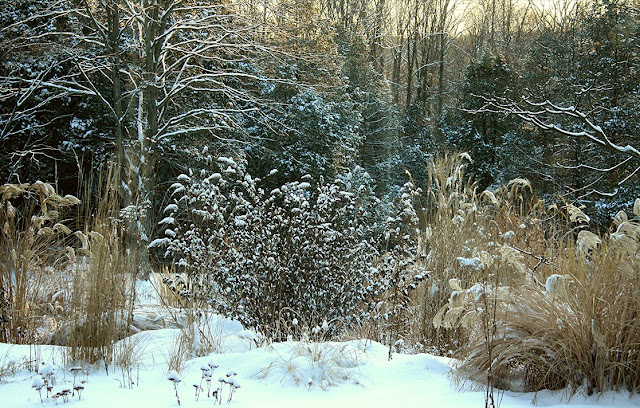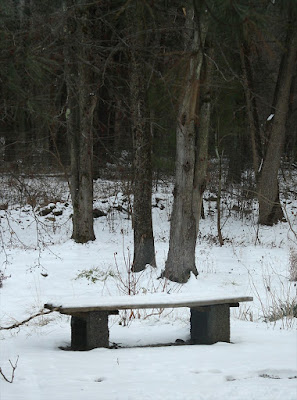 |
| The High Line's Section 1 ends in a field of Prairie Dropseed (Sporobolis heterolepis). Section 2 will open this spring. |
Tuesday, January 25, 2011
The High Line: Section 2
Labels:
High Line,
Piet Oudolf,
Sporobolus heterolepis
Friday, January 21, 2011
Sunrise on new snow: watching from inside
Another four or five inches of light snow fell last night. Being born in the south where snow might be seen once in five years, I still delight in it, even after several storms in a row. But I haven't wanted to walk through this. Instead, I watch from inside the house.
The garden is almost gone, buried under layers of ice. The surrounding forest trees are much more prominent now and will have to carry the bulk of interest until spring. Even the structural elements--the gravel paths, stone walls, the pond--are invisible until the spring thaw.
The dark, leaden scaffolding of Baptisia australis (below) is still holding its own well against ice and snow, but the grasses are getting ragged and are ready for burning. The disappearance of most of the vegetable garden points up need for more structure at this time of year. The hornbeam hedge I started last year will make a strong winter statement, once it attains its "hedgeness."
And some other structural elements (columns, mounds, geometric shapes--of pruned shrubs, wood, stone, perhaps) may give just enough entertainment to the eye--strong, simple shapes contrasting with the busy, almost chaotic lines of the forest trees--without interrupting the view into the woods.
But on a day like today, the ethereal tracery of the trees, the washes of early morning sun light, the glimpse of the hill on the opposite side of the valley, just visible through the forest, are enough.
The garden is almost gone, buried under layers of ice. The surrounding forest trees are much more prominent now and will have to carry the bulk of interest until spring. Even the structural elements--the gravel paths, stone walls, the pond--are invisible until the spring thaw.
The dark, leaden scaffolding of Baptisia australis (below) is still holding its own well against ice and snow, but the grasses are getting ragged and are ready for burning. The disappearance of most of the vegetable garden points up need for more structure at this time of year. The hornbeam hedge I started last year will make a strong winter statement, once it attains its "hedgeness."
And some other structural elements (columns, mounds, geometric shapes--of pruned shrubs, wood, stone, perhaps) may give just enough entertainment to the eye--strong, simple shapes contrasting with the busy, almost chaotic lines of the forest trees--without interrupting the view into the woods.
But on a day like today, the ethereal tracery of the trees, the washes of early morning sun light, the glimpse of the hill on the opposite side of the valley, just visible through the forest, are enough.
Wednesday, January 12, 2011
New snow: sense of place
Unity of house and garden was uppermost in my mind when we moved to Federal Twist Road at the start of 2005. The mid-1960s house, raised on a man-made hillock above the surrounding wet, is low and long, with a low roof line and wide eaves that give it a hooded look from the distance. The house was painted a taupe color that blends well with the surrounding woods. It was clear from the start that this house could only overlook a naturalistic garden, a garden appropriate to this place.
In a photo taken last fall (below), the looming presence of the house dominates the garden yet blends easily into the wooded setting. In the growing season, a screen of grasses and mature trees surrounding it make it recede into the background, almost disappear.
But that's all about how the house looks from the outside. Although the style of the garden responds most directly to its external appearance, most garden viewing takes place inside the house, particularly in winter months and inclement weather.
Throughout December, when holiday activities kept me in our Brooklyn house -- really just a series of painted boxes with limited views out -- for the better part of a month, I found myself literally craving these woodland views. I guess I have to admit that old cliche about the healing quality of nature is true, much as I want to dismiss it as trite and sentimental.
Now I'm spending a week in the country. On this winter weekend, with accumulating snow keeping me inside, I've been made acutely aware that outside is inside too, so I set about making a photographic record of the visual unity of house and garden -- but this time from the inside looking out.
Though the living room and study give all-encompassing views of the garden and surrounding landscape through a window wall ...
... in fact, each room in the house, including kitchen and bathrooms, offers substantial views out.
The dining room view out the opposite side toward the driveway and Federal Twist Road ...
... the guest bedroom, with a view onto the gravel terrace, across the garden, into the woods ...
... the master bedroom window, looking out the far end of the house to an old stone row ...
... the view out the side window of the study, onto the woodland garden, and a simple, rustic bench made of two 60s-era concrete blocks and planks ...
... and another view out the back of the study to one of three Sycamores planted as saplings when the house was built in 1965 (note the colors and textures of the bark, repeated in the background landscape!).
Sense of place is what this garden is about. I was intrigued when Peter Holt quoted Claire E. Sawyers (The Authentic Garden: Five Principles for Cultivating a Sense of Place) because it introduced me to the Japanese concept of wabi-sabi. As I wrote to Peter, "I've been trying to put this into words, and thanks to you, I've discovered my garden fits into this centuries-long tradition--another little miracle... like reading my own autobiography written by dead people from another culture and another time."
Sawyers suggests that westerners' longing to create Japanese gardens comes from a confusion of those gardens' specifically Japanese cultural influences with their more universal wabi-sabi character, which is admiration for things or places that can be characterized as humble, transient, beautifully worn, with the patina of use and age, the natural, the unpretentious, the familiar seen in a new way.
As one authority, she quotes Lenord Koren (Wabi-Sabi for Artists, Designers, Poets and Philosophers): "Wabi-sabi represents the exact opposite of the Western ideal of great beauty as something monumental, spectacular, and enduring. Wabi-sabi is not found in nature at moments of bloom and lushness, but at moments of inception or subsiding. Wabi-sabi is not about gorgeous flowers, majestic trees, or bold landscapes. Wabi-sabi is about the minor and the hidden, the tentative and the ephemeral..." I might even add, the informal.
Thus, Sawyers suggests that one way to cultivate sense of place is to use humble materials, materials that through nature or culture are appropriate to the site. Our house is very much at one with this landscape and this garden. It's a simple house, really a profusely fenestrated shed-like structure; built of wood and stone, and colored much like the bark of a tree in winter, it takes on the character of the woodlands and garden surrounding it. It welcomes the outside in, in almost any direction you look. Very much a wabi-sabi relationship of house and garden, I think.
The wide, over-hanging eves and part of the window frame in the next photo give that fact a hard reality, contrasting the ordered, rigid, yet simple man-made structure with the looseness and complexity of the grasses and trees.
So what does this Japanese artistic concept of wabi-sabi have to do with my house, grasses and woods? I'd say it gives me a theoretical and historical context, it gives me a place to belong, makes me part of a group, though not necessarily a Japanese only group.
Not at all, certainly, for we in North America have a long tradition of naturalistic planting through imports such as Jens Jensen, a German who came to America and became an early advocate of prairies and managed natural landscapes, and our own native Frank Lloyd Wright, who gave us the concept of the "prairie house," of which my own is a descendant, and who also brought much of the Japanese aesthetic to his work. And, of course, more recently, the work of Oehme, van Sweden Associates, who pioneered American naturalistic planting over the last decades of the 20th century, and continue to do so.
In most ways, I'm doing nothing that hasn't been done by others for decades. With one possible exception, because I do carry one aspect of my "naturalistic" approach to the extreme, doing virtually nothing to improve a difficult, heavy clay soil or very poor drainage. The plants must be capable of adapting to these conditions or they languish and die. Ironically, two grasses from different continents are among the most successful: panicums, from North American, and miscanthus, from Japan.
We really don't even need the term wabi-sabi since these ideas have become a part of our garden culture by osmosis, percolating into our history and culture through innumerable routes.
But the Japanese source of the term is a useful reminder and prod to appreciation of classically Japanese detail such as the irregular line and asymmetry of the bare dogwood in the foreground of the photo below, and to the detail of our house, which owes much to Japanese influence.
The point of all this? That the garden is indeed part of the house, and the house a part of the garden. This relationship dictates the naturalistic look and style of the garden. Japanese influences are pervasive, but they have been thoroughly assimilated into the the local context of a wild wood in western New Jersey.
Subscribe to:
Comments (Atom)



















